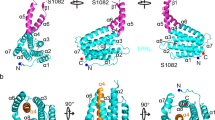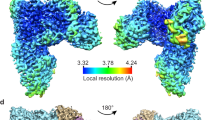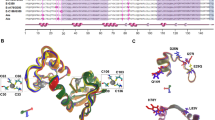Abstract
The adenovirus type 5 E1B-55 kDa oncoprotein forms a complex with the tumor suppressor p53 and inactivates it. E1B-55 kDa and p53 are each capable of forming oligomers. We mapped the oligomerization domain of E1B-55 kDa to the central portion of the protein. Disturbing E1B-55 kDa self-association by point mutations at residues 285/286 or 307 not only impairs its intracellular localization to the cytoplasmic clusters, but in addition, its association with p53. Strikingly, tetramerization of p53 is also required for efficient association with E1B-55 kDa. Moreover, two different E1B-55 kDa mutants defective for p53 binding but proficient for oligomerization can trans-complement each other for p53 relocalization. We propose that the homo-oligomerization of each component enables efficient interaction between E1B-55 kDa and p53 through increased avidity.
This is a preview of subscription content, access via your institution
Access options
Subscribe to this journal
Receive 50 print issues and online access
$259.00 per year
only $5.18 per issue
Buy this article
- Purchase on Springer Link
- Instant access to full article PDF
Prices may be subject to local taxes which are calculated during checkout








Similar content being viewed by others
References
Araujo FD, Stracker TH, Carson CT, Lee DV, Weitzman MD . (2005). Adenovirus type 5 E4orf3 protein targets the Mre11 complex to cytoplasmic aggresomes. J Virol 79: 11382–11391.
Baker A, Rohleder KJ, Hanakahi LA, Ketner G . (2007). Adenovirus E4 34k and E1b 55k oncoproteins target host DNA ligase IV for proteasomal degradation. J Virol 81: 7034–7040.
Balagurumoorthy P, Sakamoto H, Lewis MS, Zambrano N, Clore GM, Gronenborn AM et al. (1995). Four p53 DNA-binding domain peptides bind natural p53-response elements and bend the DNA. Proc Natl Acad Sci USA 92: 8591–8595.
Berk AJ . (2005). Recent lessons in gene expression, cell cycle control, and cell biology from adenovirus. Oncogene 24: 7673–7685.
Blair Zajdel ME, Blair GE . (1988). The intracellular distribution of the transformation-associated protein p53 in adenovirus-transformed rodent cells. Oncogene 2: 579–584.
Bode AM, Dong Z . (2004). Post-translational modification of p53 in tumorigenesis. Nat Rev Cancer 4: 793–805.
Chene P . (2001). The role of tetramerization in p53 function. Oncogene 20: 2611–2617.
Dallaire F, Blanchette P, Groitl P, Dobner T, Branton PE . (2009). Identification of integrin alpha3 as a new substrate of the adenovirus E4orf6/E1B 55-kilodalton E3 ubiquitin ligase complex. J Virol 83: 5329–5338.
Davis AC, Shulman MJ . (1989). IgM—molecular requirements for its assembly and function. Immunol Today 10: 118–122; 127–8.
de Jager M, van Noort J, van Gent DC, Dekker C, Kanaar R, Wyman C . (2001). Human Rad50/Mre11 is a flexible complex that can tether DNA ends. Mol Cell 8: 1129–1135.
Dissanayake S, Hay FC, Roitt IM . (1977). The binding constants of IgM rheumatoid factors and their univalent fragments for native and aggregated human IgG. Immunology 32: 309–318.
Dobbelstein M, Roth J, Kimberly WT, Levine AJ, Shenk T . (1997). Nuclear export of the E1B 55-kDa and E4 34-kDa adenoviral oncoproteins mediated by a rev-like signal sequence. EMBO J 16: 4276–4284.
Dobner T, Horikoshi N, Rubenwolf S, Shenk T . (1996). Blockage by adenovirus E4orf6 of transcriptional activation by the p53 tumor suppressor. Science 272: 1470–1473.
Fleisig HB, Orazio NI, Liang H, Tyler AF, Adams HP, Weitzman MD et al. (2007). Adenoviral E1B55 K oncoprotein sequesters candidate leukemia suppressor sequence-specific single-stranded DNA-binding protein 2 into aggresomes. Oncogene 26: 4797–4805.
Goodrum FD, Shenk T, Ornelles DA . (1996). Adenovirus early region 4 34-kilodalton protein directs the nuclear localization of the early region 1B 55-kilodalton protein in primate cells. J Virol 70: 6323–6335.
Gonzalez RA, Flint SJ . (2002). Effects of mutations in the adenoviral E1B 55-kilodalton protein coding sequence on viral late mRNA metabolism. J Virol 76: 4507–4519.
Grand RJ, Mustoe T, Roberts S, Gallimore PH . (1995). The quaternary structure of the adenovirus 12 early region 1B 54 K protein. Virology 207: 255–259.
Harada JN, Shevchenko A, Pallas DC, Berk AJ . (2002). Analysis of the adenovirus E1B-55K-anchored proteome reveals its link to ubiquitination machinery. J Virol 76: 9194–9206.
Haupt Y, Maya R, Kazaz A, Oren M . (1997). Mdm2 promotes the rapid degradation of p53. Nature 387: 296–299.
Horn HF, Vousden KH . (2007). Coping with stress: multiple ways to activate p53. Oncogene 26: 1306–1316.
Horridge JJ, Leppard KN . (1998). RNA-binding activity of the E1B 55-kilodalton protein from human adenovirus type 5. J Virol 72: 9374–9379.
Konig C, Roth J, Dobbelstein M . (1999). Adenovirus type 5 E4orf3 protein relieves p53 inhibition by E1B-55-kilodalton protein. J Virol 73: 2253–2262.
Kubbutat MH, Jones SN, Vousden KH . (1997). Regulation of p53 stability by Mdm2. Nature 387: 299–303.
Kubbutat MH, Ludwig RL, Ashcroft M, Vousden KH . (1998). Regulation of Mdm2-directed degradation by the C terminus of p53. Mol Cell Biol 18: 5690–5698.
Leppard KN, Everett RD . (1999). The adenovirus type 5 E1b 55 K and E4 Orf3 proteins associate in infected cells and affect ND10 components. J Gen Virol 80 (Part 4): 997–1008.
Levine AJ . (2009). The common mechanisms of transformation by the small DNA tumor viruses: the inactivation of tumor suppressor gene products: p53. Virology 384: 285–293.
Lilyestrom W, Klein MG, Zhang R, Joachimiak A, Chen XS . (2006). Crystal structure of SV40 large T-antigen bound to p53: interplay between a viral oncoprotein and a cellular tumor suppressor. Genes Dev 20: 2373–2382.
Lin J, Chen J, Elenbaas B, Levine AJ . (1994). Several hydrophobic amino acids in the p53 amino-terminal domain are required for transcriptional activation, binding to mdm-2 and the adenovirus 5 E1B 55-kD protein. Genes Dev 8: 1235–1246.
Liu Y, Shevchenko A, Berk AJ . (2005). Adenovirus exploits the cellular aggresome response to accelerate inactivation of the MRN complex. J Virol 79: 14004–14016.
Maki CG . (1999). Oligomerization is required for p53 to be efficiently ubiquitinated by MDM2. J Biol Chem 274: 16531–16535.
Marshall LJ, Moore AC, Ohki M, Kitabayashi I, Patterson D, Ornelles DA . (2008). RUNX1 permits E4orf6-directed nuclear localization of the adenovirus E1B-55 K protein and associates with centers of viral DNA and RNA synthesis. J Virol 82: 6395–6408.
Martin ME, Berk AJ . (1998). Adenovirus E1B 55 K represses p53 activation in vitro. J Virol 72: 3146–3154.
Olivier M, Petitjean A, Marcel V, Petre A, Mounawar M, Plymoth A et al. (2009). Recent advances in p53 research: an interdisciplinary perspective. Cancer Gene Ther 16: 1–12.
Querido E, Blanchette P, Yan Q, Kamura T, Morrison M, Boivin D et al. (2001a). Degradation of p53 by adenovirus E4orf6 and E1B55 K proteins occurs via a novel mechanism involving a Cullin-containing complex. Genes Dev 15: 3104–3117.
Querido E, Marcellus RC, Lai A, Charbonneau R, Teodoro JG, Ketner G et al. (1997). Regulation of p53 levels by the E1B 55-kilodalton protein and E4orf6 in adenovirus-infected cells. J Virol 71: 3788–3798.
Querido E, Morrison MR, Chu-Pham-Dang H, Thirlwell SW, Boivin D, Branton PE . (2001b). Identification of three functions of the adenovirus e4orf6 protein that mediate p53 degradation by the E4orf6–E1B55 K complex. J Virol 75: 699–709.
Roth J, Konig C, Wienzek S, Weigel S, Ristea S, Dobbelstein M . (1998). Inactivation of p53 but not p73 by adenovirus type 5 E1B 55-kilodalton and E4 34-kilodalton oncoproteins. J Virol 72: 8510–8516.
Sarnow P, Ho YS, Williams J, Levine AJ . (1982a). Adenovirus E1b-58 kD tumor antigen and SV40 large tumor antigen are physically associated with the same 54 kD cellular protein in transformed cells. Cell 28: 387–394.
Schwartz RA, Lakdawala SS, Eshleman HD, Russell MR, Carson CT, Weitzman MD . (2008). Distinct requirements of adenovirus E1b55 K protein for degradation of cellular substrates. J Virol 82: 9043–9055.
Shaulian E, Zauberman A, Ginsberg D, Oren M . (1992). Identification of a minimal transforming domain of p53: negative dominance through abrogation of sequence-specific DNA binding. Mol Cell Biol 12: 5581–5592.
Shen Y, Kitzes G, Nye JA, Fattaey A, Hermiston T . (2001). Analyses of single-amino-acid substitution mutants of adenovirus type 5 E1B-55 K protein. J Virol 75: 4297–4307.
Singh RK, Iyappan S, Scheffner M . (2007). Hetero-oligomerization with MdmX rescues the ubiquitin/Nedd8 ligase activity of RING finger mutants of Mdm2. J Biol Chem 282: 10901–10907.
Steegenga WT, Riteco N, Jochemsen AG, Fallaux FJ, Bos JL . (1998). The large E1B protein together with the E4orf6 protein target p53 for active degradation in adenovirus infected cells. Oncogene 16: 349–357.
Stracker TH, Carson CT, Weitzman MD . (2002). Adenovirus oncoproteins inactivate the Mre11-Rad50-NBS1 DNA repair complex. Nature 418: 348–352.
Teodoro JG, Branton PE . (1997). Regulation of p53-dependent apoptosis, transcriptional repression, and cell transformation by phosphorylation of the 55-kilodalton E1B protein of human adenovirus type 5. J Virol 71: 3620–3627.
Wienzek S, Roth J, Dobbelstein M . (2000). E1B 55-kilodalton oncoproteins of adenovirus types 5 and 12 inactivate and relocalize p53, but not p51 or p73, and cooperate with E4orf6 proteins to destabilize p53. J Virol 74: 193–202.
Zantema A, Schrier PI, Davis-Olivier A, van Laar T, Vaessen RT, van der EA . (1985). Adenovirus serotype determines association and localization of the large E1B tumor antigen with cellular tumor antigen p53 in transformed cells. Mol Cell Biol 5: 3084–3091.
Zhao LY, Liao D . (2003). Sequestration of p53 in the cytoplasm by adenovirus type 12 E1B 55-kilodalton oncoprotein is required for inhibition of p53-mediated apoptosis. J Virol 77: 13171–13181.
Acknowledgements
We thank C Hippel and A Dickmanns for excellent technical assistance. We thank M Oren (Rehovot) and K Vousden (Glasgow) for plasmids and cells. Our work was supported by the German Cancer Aid/Dr Mildred Scheel Stiftung, the EU 6th Framework Program (Integrated Project Active p53), the German Research Foundation (DFG), the Wilhelm Sander Stiftung, the Statens Sundhedsvidenskabelige Forskningsråd of Denmark, the Danish Cancer Society, the Fonden til Lægevidenskabens Fremme, the Novonordisk fonden, the MSc/PhD Molecular Biology Program at the University of Göttingen, and The Göttingen Graduate School for Neurosciences and Molecular Biosciences (GGNB).
Author information
Authors and Affiliations
Corresponding author
Additional information
Supplementary Information accompanies the paper on the Oncogene website (http://www.nature.com/onc)
Supplementary information
Rights and permissions
About this article
Cite this article
Morawska-Onyszczuk, M., Bieńkowska-Szewczyk, K. & Dobbelstein, M. Self-association of adenovirus type 5 E1B-55 kDa as well as p53 is essential for their mutual interaction. Oncogene 29, 1773–1786 (2010). https://doi.org/10.1038/onc.2009.461
Received:
Revised:
Accepted:
Published:
Issue Date:
DOI: https://doi.org/10.1038/onc.2009.461



